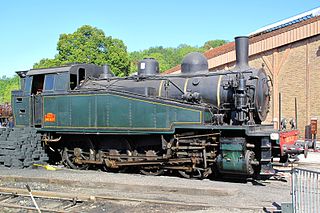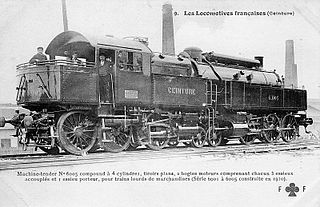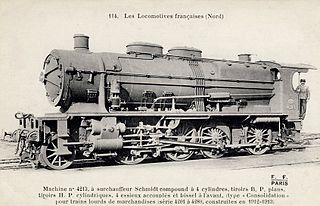This article needs additional citations for verification .(December 2013) (Learn how and when to remove this template message) |
| État 231-501 to 231-783 | |||||||||||||||||||||||||||||||||||||||||||
|---|---|---|---|---|---|---|---|---|---|---|---|---|---|---|---|---|---|---|---|---|---|---|---|---|---|---|---|---|---|---|---|---|---|---|---|---|---|---|---|---|---|---|---|
 | |||||||||||||||||||||||||||||||||||||||||||
| |||||||||||||||||||||||||||||||||||||||||||
| |||||||||||||||||||||||||||||||||||||||||||
| |||||||||||||||||||||||||||||||||||||||||||
| |||||||||||||||||||||||||||||||||||||||||||
État 231-500 to 231-783 was a series of 4-6-2 steam locomotives of the Chemin de fer de l'État ("the État").

Under the Whyte notation for the classification of steam locomotives, 4-6-2 represents the wheel arrangement of four leading wheels on two axles, six powered and coupled driving wheels on three axles and two trailing wheels on one axle. The 4-6-2 locomotive became almost globally known as a Pacific type.
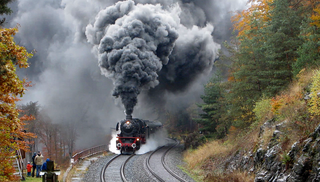
A steam locomotive is a type of railway locomotive that produces its pulling power through a steam engine. These locomotives are fueled by burning combustible material – usually coal, wood, or oil – to produce steam in a boiler. The steam moves reciprocating pistons which are mechanically connected to the locomotive's main wheels (drivers). Both fuel and water supplies are carried with the locomotive, either on the locomotive itself or in wagons (tenders) pulled behind.
289 engines of this series were built starting in 1914, with deliveries from 1916 through 1923. They replaced and supplemented the 231 B that had a tendency to derail. The class was numbered 231-501 to 231-783 by the État and 231.C.501 to 231.C.783 by the SNCF; with class letters "C" through "H" used depending on the level of rebuilding and modernisation.

A derailment occurs when a vehicle such as a train runs off its rails. This does not necessarily mean that it leaves its track. Although many derailments are minor, all result in temporary disruption of the proper operation of the railway system, and they are potentially seriously hazardous to human health and safety. Usually, the derailment of a train can be caused by a collision with another object, an operational error, the mechanical failure of tracks, such as broken rails, or the mechanical failure of the wheels. In emergency situations, deliberate derailment with derails or catch points is sometimes used to prevent a more serious accident.

The Société nationale des chemins de fer français is France's national state-owned railway company. Founded in 1938, it operates the country's national rail traffic along with Monaco, including the TGV, France's high-speed rail network. Its functions include operation of railway services for passengers and freight, and maintenance and signalling of rail infrastructure. The railway network consists of about 32,000 km (20,000 mi) of route, of which 1,800 km (1,100 mi) are high-speed lines and 14,500 km (9,000 mi) electrified. About 14,000 trains are operated daily.
The first locomotives were built by Fives-Lille; however only the first locomotive has entered service before the city of Lille was overrun by the advancing German Army during World War I. Five others were seized by the Germans. Subsequently orders were placed with North British Locomotive Company for 40 locomotives. Five of these were lost when the cargo ship carrying them was sunk during an attack by a German submarine; they were later replaced by construction of new locomotives. Post-war production was with Fives-Lille, Schneider et Cie., and the newly founded Compagnie générale de Construction de locomotives (Batignolles-Châtillon). Four of the five taken away by the Germans returned to the État after the end of the war, and were given numbers at the end of the class-list. The fifth locomotive went to the Chemins de Fer du Nord , where it was numbered 3.1150; the SNCF renumbered it 2-231.B.1 until 1947 when it was transferred to the Région Ouest and renumbered 3-231.F.784. [1]

Fives-Lille was a French engineering company located at Fives, a suburb of Lille. It is now part of the Fives Group.

Lille is a city at the northern tip of France, in French Flanders. On the Deûle River, near France's border with Belgium, it is the capital of the Hauts-de-France region, the prefecture of the Nord department, and the main city of the European Metropolis of Lille.

The North British Locomotive Company was created in 1903 through the merger of three Glasgow locomotive manufacturing companies; Sharp, Stewart and Company, Neilson, Reid and Company and Dübs and Company, creating the largest locomotive manufacturing company in Europe and the British Empire.
The engines were famous for their service on passenger trains, notably on the Paris-Le Havre and Paris-Le Mans-Rennes expresses.

Paris is the capital and most populous city of France, with an area of 105 square kilometres and an official estimated population of 2,140,526 residents as of 1 January 2019. Since the 17th century, Paris has been one of Europe's major centres of finance, commerce, fashion, science, and the arts.
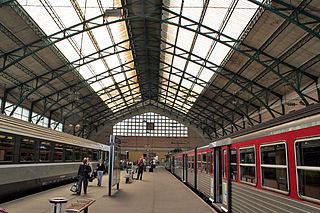
Le Havre is the main railway station located in Le Havre, Seine-Maritime, France. The station was opened on 22 March 1847 and is located on the Paris–Le Havre railway. The train services are operated by SNCF.

Rennes railway station is situated in the town centre of Rennes, France. It is situated on the Paris–Brest, Rennes–Saint-Malo and the Rennes–Redon railways.
After World War I other companies received 231-500s thanks to government aid. They were designated 231 TP for Travaux Publics (Public Works), the former name of the Ministry of Transport.

World War I, also known as the First World War or the Great War, was a global war originating in Europe that lasted from 28 July 1914 to 11 November 1918. Contemporaneously described as "the war to end all wars", it led to the mobilisation of more than 70 million military personnel, including 60 million Europeans, making it one of the largest wars in history. It is also one of the deadliest conflicts in history, with an estimated nine million combatants and seven million civilian deaths as a direct result of the war, while resulting genocides and the 1918 influenza pandemic caused another 50 to 100 million deaths worldwide.
The 231 G was rated at 2,200 hp (1,600 kW). Engine 231-523 was modified in 1929 from four cylinders to three, and had Lentz valves fitted.

A cylinder is the central working part of a reciprocating engine or pump, the space in which a piston travels. Multiple cylinders are commonly arranged side by side in a bank, or engine block, which is typically cast from aluminum or cast iron before receiving precision machine work. Cylinders may be sleeved or sleeveless. A sleeveless engine may also be referred to as a "parent-bore engine".
Hugo Lentz (1859–1944) was an Austrian mechanical engineer, born in South Africa. He was the inventor of many award-winning improvements to the steam engine.
